From Carbon Calculators to Energy System Analysis in Cities
Abstract
:1. Introduction
1.1. Shifting to 100% Renewable Energy
- Resources: fuels, electricity (source);
- Conversion/exchange and storage technologies (system);
- Final demand: user behavior end-uses (Service).
- 100% renewable heat and electricity and fossil free transport and industry;
- Sustainable biomass;
- Isolated energy system;
- System balances itself;
- Technically feasible technologies.
1.2. Aim of this Article
- The 100% renewable city energy system configuration and role of the technologies within the national 100% renewable energy system;
- The implications for Sønderborg for bioenergy, wind, and solar resources within the context of the national energy system and key sustainability factors.
2. Methodology
- City energy system diagnosis today: Define boundary conditions for the city and gather energy dataset for the city for a recent year;
- National long-term energy study and per capita data: Locate a national study that has both an energy system scenario for a recent year and that looks at 100% renewable energy in the long-term, i.e., 2050. The scenarios should meet specific characteristics, which are described in more detail below;
- Per capita energy data for the city in the future: Quantify per capita energy data for city energy system based on the national long term 100% renewable system (2050);
- Analyze and balance the city energy system: Using the per capita data for the city in 2050 and an energy system analysis tool, assess the city energy system in 2050 with regards to the sustainability factors.
2.1. Step One: City Energy System Diagnosis Today
2.2. Step Two: National Long-Term Energy Study and Per Capita Data
2.3. Step Three: Per Capita Data for the City in the Future
2.4. Step Four: Analyze and Balance the City Energy System
- The local energy system that exists today, e.g., district heating network (Step 1);
- The energy system of the country in 2050 and the technologies that can be used locally (Step 2 and 3);
- The sustainability factors are met, for example all energy sectors are included and energy demands are met, resource consumption is low and energy is efficiently used, i.e., district heat is not being overproduced (Step 4)
2.4.1. EnergyPLAN
2.4.2. Balancing the National Energy System with Power Plants
2.4.3. Using the Simulation Tool
3. Applying the Methodology in Sønderborg
3.1. Step One: City Energy System Diagnosis Today
3.2. Step Two: National Long-Term Energy Study and Per Capita Data
3.2.1. Danish Changes to 2050
- Heat demand in buildings was reduced by 40%, which was based on the cost of renovations against the cost of supplying heat.
- Household electricity savings were reduced by 25%, which was based on three factors:
- ○
- The future increase of equipment of 10%;
- ○
- Technical savings of 15%;
- ○
- Behavioral savings of 20%.
- Industry and service sectors, including agriculture and construction, assumed business as the usual growth of 40%. This energy demand was reduced via savings for fuel and electricity and a coordinated implementation of district heating and cooling, electric heat pumps, and replacement of fossil fuels with electricity, biomass, and upgraded hydrogen (methanated biogas).
3.2.2. Comparing the Per Capita Energy Data of Denmark and Sønderborg
3.3. Step Three: Per Capita Energy Data for the City in the Future
4. Results: Step Four—Analyze and Balance the City Energy System
4.1. Data Type 1—Resource Inputs
4.2. Data Types 2 and 3—Conversion Technologies (Production) and Storages and Exchange
4.2.1. Electricity Production
4.2.2. District Heating and Private Heating
4.3. Data types 4, 5, and 6—Final Energy Demands, End-Use Demands and Total Energy Sector Demands
4.4. Potential Investments Towards 2050
5. Discussion and Conclusions
Author Contributions
Funding
Acknowledgments
Conflicts of Interest
References
- The European Commission. 2030 Climate & Energy Framework. Available online: https://ec.europa.eu/clima/policies/strategies/2030_en (accessed on 15 April 2019).
- Covenant of Mayors for Climate & Energy. Plans & Actions. Available online: https://www.covenantofmayors.eu/plans-and-actions/action-plans.html. (accessed on 15 April 2019).
- Covenant of Mayors for Climate Energy. Reporting Guidelines on Sustainable Energy Action Plan. and Monitoring. 2014. Available online: https://www.covenantofmayors.eu/IMG/pdf/Reporting_Guidelines_SEAP_and_Monitoring_v2-0-2.pdf (accessed on 17 June 2019).
- Coelho, S.; Russo, M.; Oliveira, R.; Monteiro, A.; Lopes, M.; Borrego, C. Sustainable energy action plans at city level: A Portuguese experience and perception. J. Clean. Prod. 2018, 176, 1223–1230. [Google Scholar] [CrossRef] [Green Version]
- Delponte, I.; Pittaluga, I.; Schenone, C. Monitoring and evaluation of Sustainable Energy Action Plan: Practice and perspective. Energy Policy 2017, 100, 9–17. [Google Scholar] [CrossRef]
- Sperling, K.; Hvelplund, F.; Mathiesen, B.V. Centralisation and decentralisation in strategic municipal energy planning in Denmark. Energy Policy 2011, 39, 1338–1351. [Google Scholar] [CrossRef]
- Paardekooper, S.; Lund, R.; Lund, H. Smart Energy Systems. In Energy Storage Options and Their Environmental Impact; Hester, R.E., Harrison, R.M., Eds.; Royal Society of Chemistry, 2019; pp. 228–260. [Google Scholar] [CrossRef]
- Mancarella, P. MES (multi-energy systems): An overview of concepts and evaluation models. Energy 2014, 65, 1–17. [Google Scholar] [CrossRef]
- Lund, H.; Østergaard, P.A.; Connolly, D.; Ridjan, I.; Mathiesen, B.V.; Hvelplund, F.; Thellufsen, J.Z.; Sorknæs, P. Energy Storage and Smart Energy Systems. Int. J. Sustain. Energy Plan. Manag. 2016, 11, 3–14. [Google Scholar]
- Dincer, I.; Acar, C. Smart energy systems for a sustainable future. Appl. Energy 2017, 194, 225–235. [Google Scholar] [CrossRef]
- Lund, H.; Østergaard, P.A.; Connolly, D.; Mathiesen, B.V. Smart energy and smart energy systems. Energy 2017, 137, 556–565. [Google Scholar] [CrossRef]
- Lund, H.; Andersen, A.N.; Østergaard, P.A.; Mathiesen, B.V.; Connolly, D. From electricity smart grids to smart energy systems-A market operation based approach and understanding. Energy 2012, 42, 96–102. [Google Scholar] [CrossRef]
- Keirstead, J.; Jennings, M.; Sivakumar, A. A review of urban energy system models: Approaches, challenges and opportunities. Renew. Sustain. Energy Rev. 2012, 16, 3847–3866. [Google Scholar] [CrossRef] [Green Version]
- Allegrini, J.; Orehounig, K.; Mavromatidis, G.; Ruesch, F.; Dorer, V.; Evins, R. A review of modeling approaches and tools for the simulation of district-scale energy systems. Renew. Sustain. Energy Rev. 2015, 52, 1391–1404. [Google Scholar] [CrossRef]
- Mirakyan, A.; De Guio, R. Integrated energy planning in cities and territories: A review of methods and tools. Renew. Sustain. Energy Rev. 2013, 22, 289–297. [Google Scholar] [CrossRef]
- Østergaard, P.A.; Mathiesen, B.V.; Möller, B.; Lund, H. A renewable energy scenario for Aalborg Municipality based on low-temperature geothermal heat, wind power and biomass. Energy 2010, 35, 4892–4901. [Google Scholar] [CrossRef]
- Østergaard, P.A. Reviewing optimisation criteria for energy systems analyses of renewable energy integration. Energy 2009, 34, 1236–1245. [Google Scholar] [CrossRef]
- Østergaard, P.A.; Lund, H. A renewable energy system in Frederikshavn using low-temperature geothermal energy for district heating. Appl. Energy 2011, 88, 479–487. [Google Scholar] [CrossRef]
- Bačeković, I.; Østergaard, P.A. A smart energy system approach vs a non-integrated renewable energy system approach to designing a future energy system in Zagreb. Energy 2018, 155, 824–837. [Google Scholar]
- Prina, M.G. Smart energy systems applied at urban level: The case of the municipality of Bressanone-Brixen Introduction. Int. J. Sustain. Energy Plan. Manag. 2015, 10, 25–26. [Google Scholar]
- De Luca, G.; Fabozzi, S.; Massarotti, N.; Vanoli, L. A renewable energy system for a nearly zero greenhouse city: Case study of a small city in southern Italy. Energy 2018, 143, 347–362. [Google Scholar] [CrossRef]
- Bačeković, I.; Østergaard, P.A. Local smart energy systems and cross-system integration. Energy 2018, 151, 812–825. [Google Scholar] [CrossRef]
- Thellufsen, J.Z.; Lund, H. Contextual Aspects of Smart City Energy Systems Analysis. Appl. Energy 2016, 183, 419–429. [Google Scholar] [CrossRef]
- Hansen, K.; Breyer, C.; Lund, H. Status and Perspectives on 100% Renewable Energy Systems. Energy 2019, 175, 471–480. [Google Scholar] [CrossRef]
- PlanEnergi. In Energy Balance Tool; 2019; Available online: https://smartencity.eu/outcomes/tools/ (accessed on 17 June 2019).
- Connolly, D.; Lund, H.; Mathiesen, B.V.; Leahy, M. A review of computer tools for analysing the integration of renewable energy into various energy systems. Appl. Energy 2010, 87, 1059–1082. [Google Scholar] [CrossRef]
- Lund, H. Renewable Energy Systems-A Smart Energy Systems Approach to the Choice and Modeling of 100% renewable Solutions; Academic Press: New York, NY, USA, 2014. [Google Scholar]
- Østergaard, P.A. Reviewing EnergyPLAN simulations and performance indicator applications in EnergyPLAN simulations. Appl. Energy 2015, 154, 921–933. [Google Scholar] [CrossRef]
- Lund, H. EnergyPLAN: Advanced Energy Systems Analysis Computer Model; Aalborg Universit: Aalborg, Denmark, 2015. [Google Scholar]
- Mathiesen, B.V.; Lund, H.; Hansen, K.; Ridjan, I.; Djørup, S.R.; Nielsen, S.; Sorknæs, P.; Thellufsen, J.Z.; Grundahl, L.; Lund, R.; et al. IDA’s Energy Vision 2050-Technical Data and Methods; The Danish Society of Engineers, IDA: Aalborg, Denmark, 2015. [Google Scholar]
- PopulationPyramid.net. Denmark 2050. Available online: http://PopulationPyramid.net (accessed on 17 June 2019).
- Østergaard, P.A. Geographic aggregation and wind power output variance in Denmark. Energy 2008, 33, 1453–1460. [Google Scholar] [CrossRef]
- Huang, Z.; Yu, H.; Peng, Z.; Zhao, M. Methods and tools for community energy planning: A review. Renew. Sustain. Energy Rev. 2015, 42, 1335–1348. [Google Scholar] [CrossRef]
- Krog, L.; Sperling, K. A comprehensive framework for strategic energy planning based on Danish and international insights. Energy Strateg. Rev. 2019, 24, 83–93. [Google Scholar] [CrossRef]
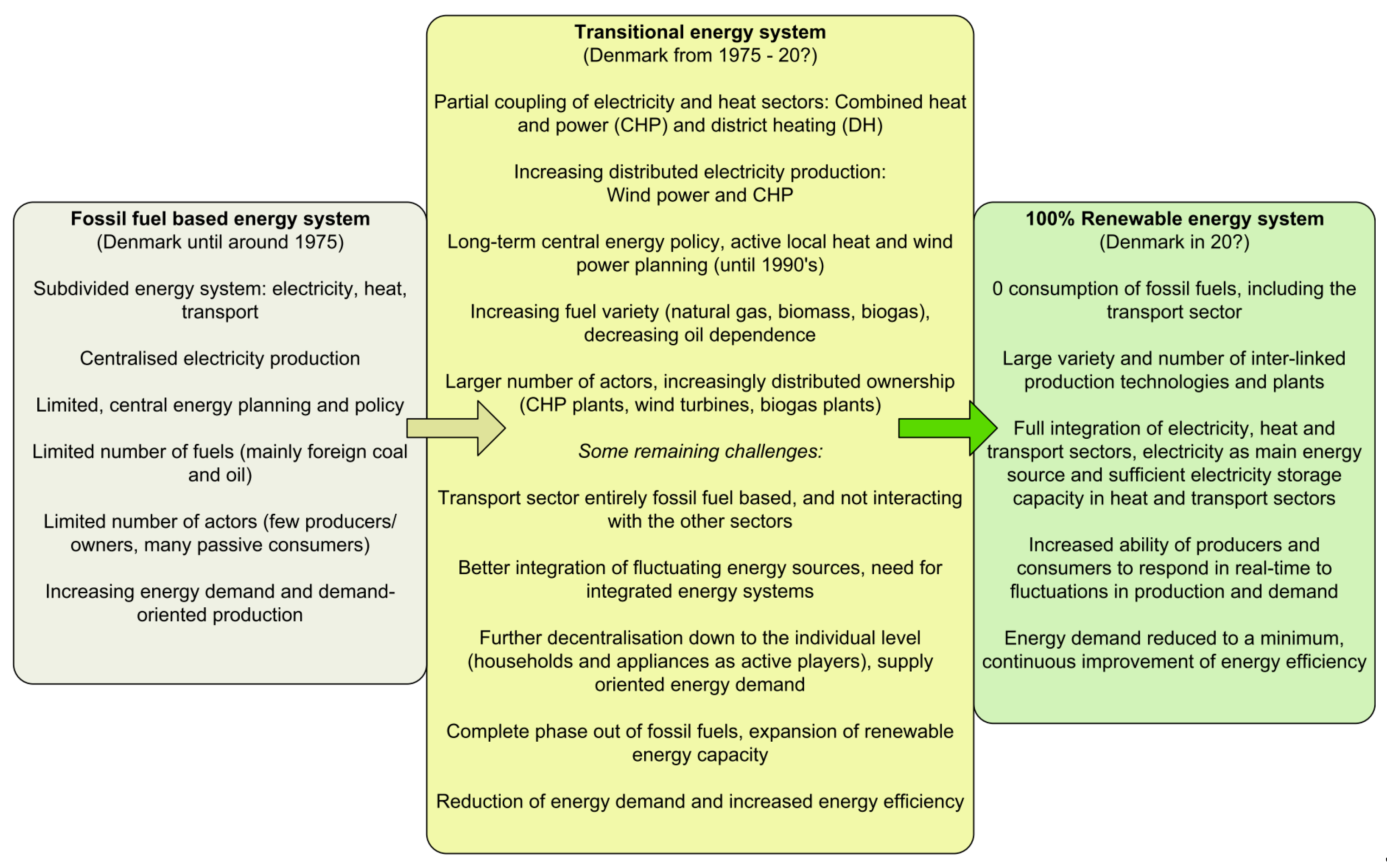
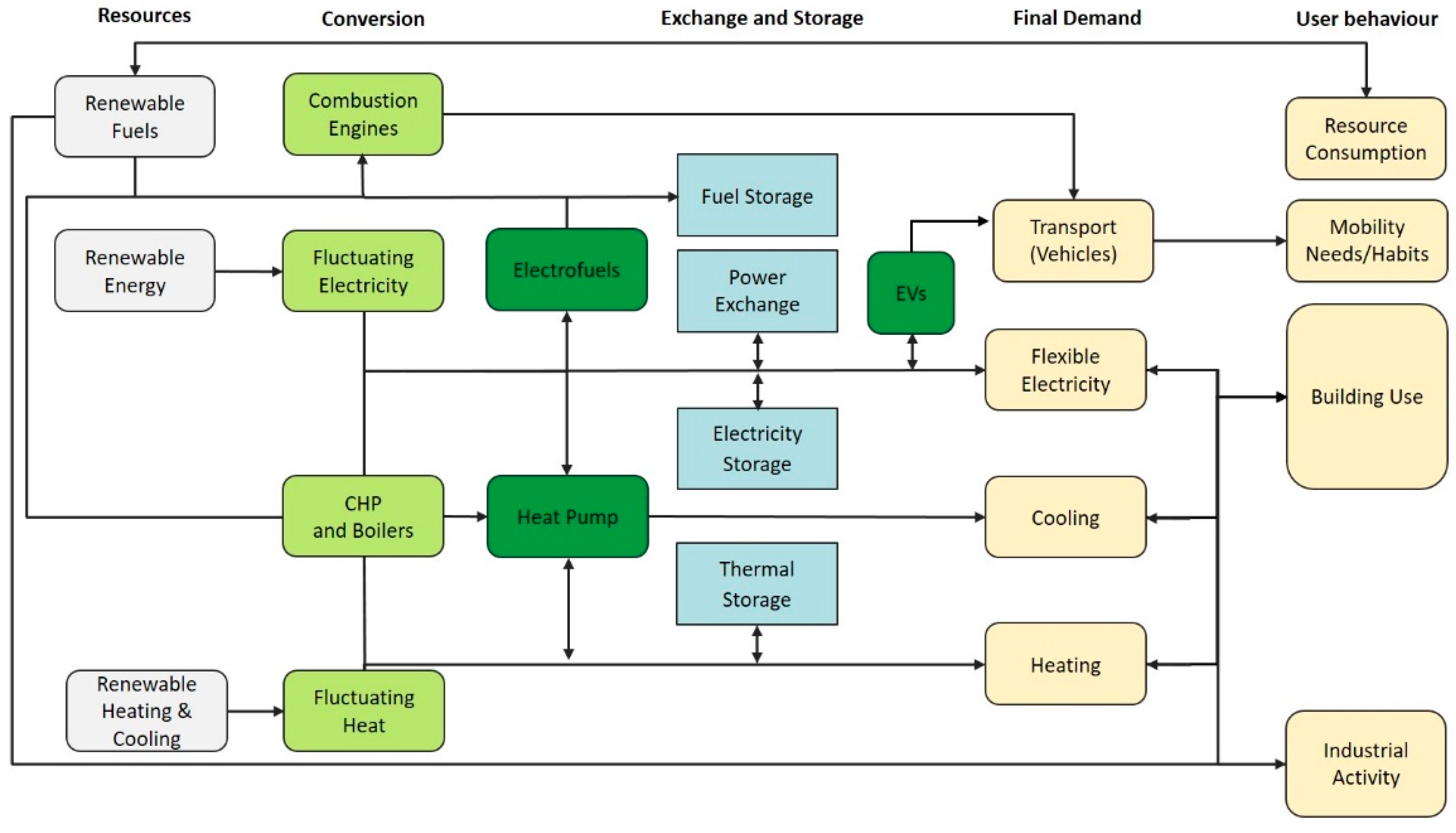
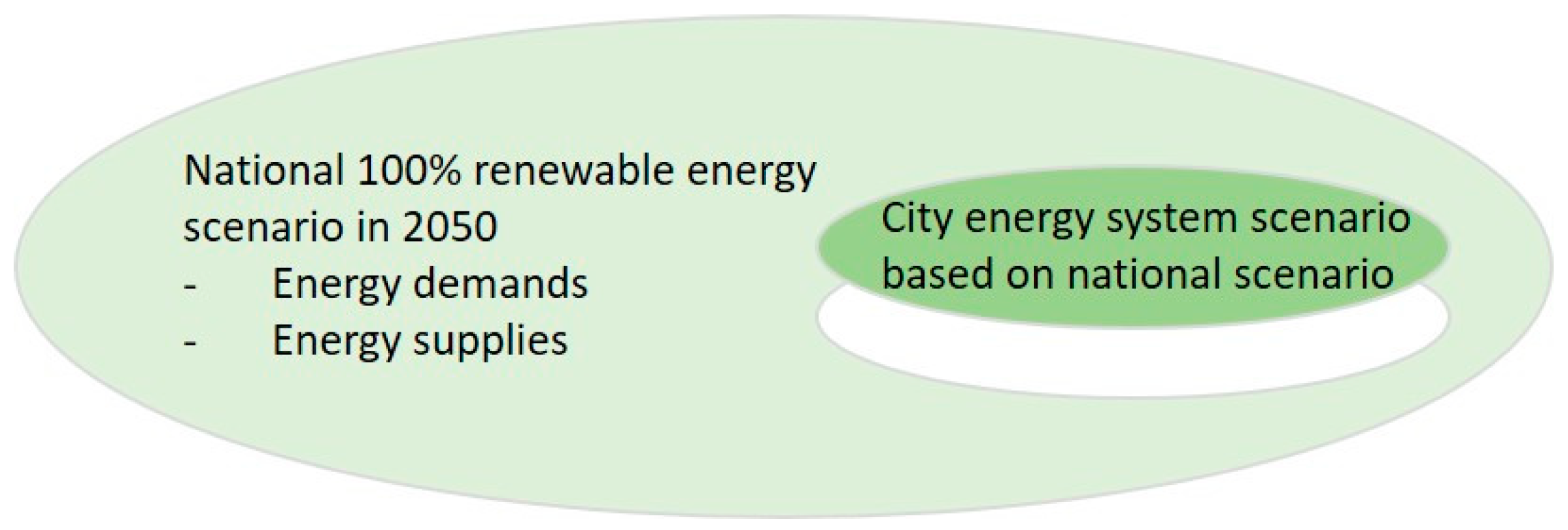
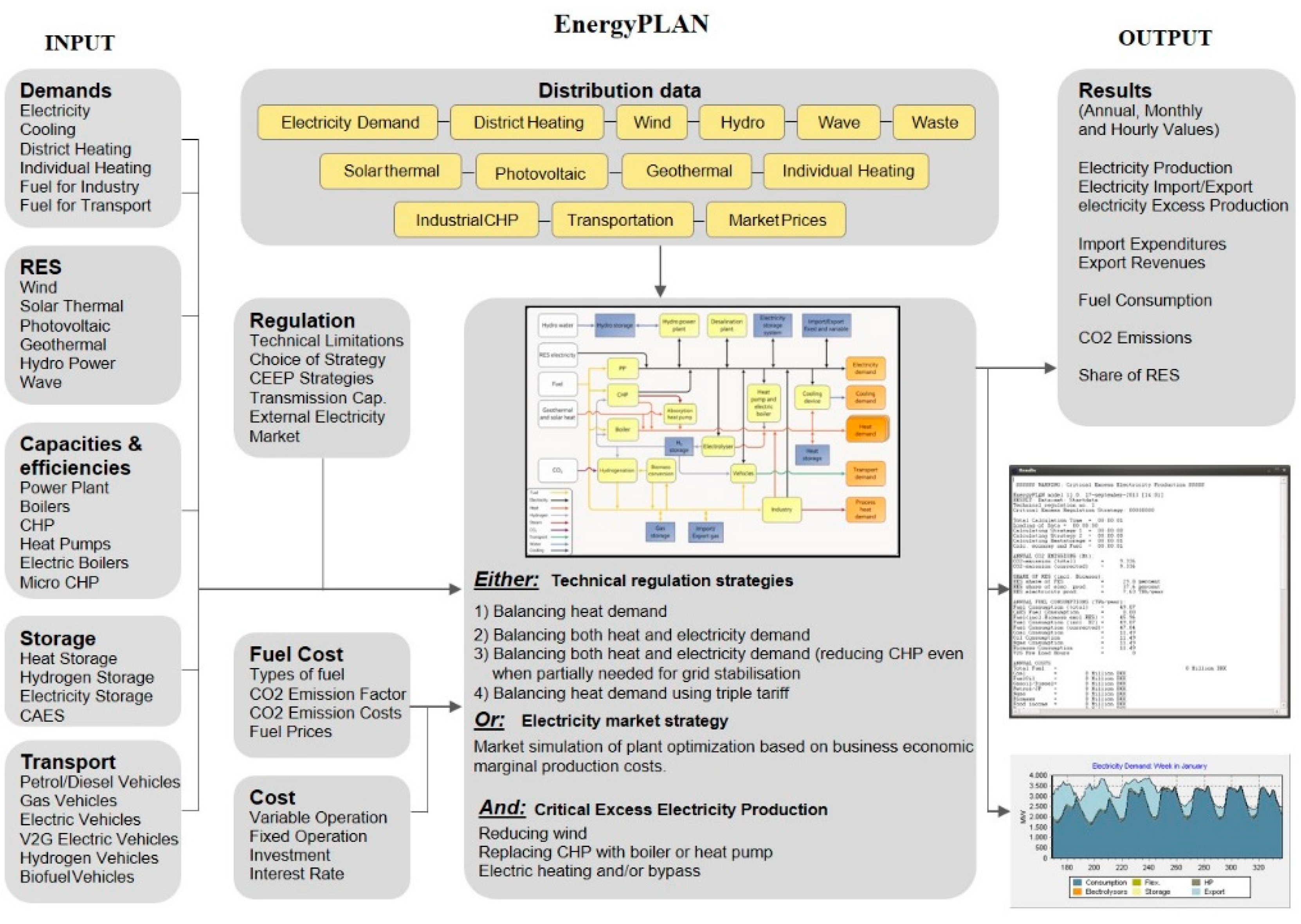
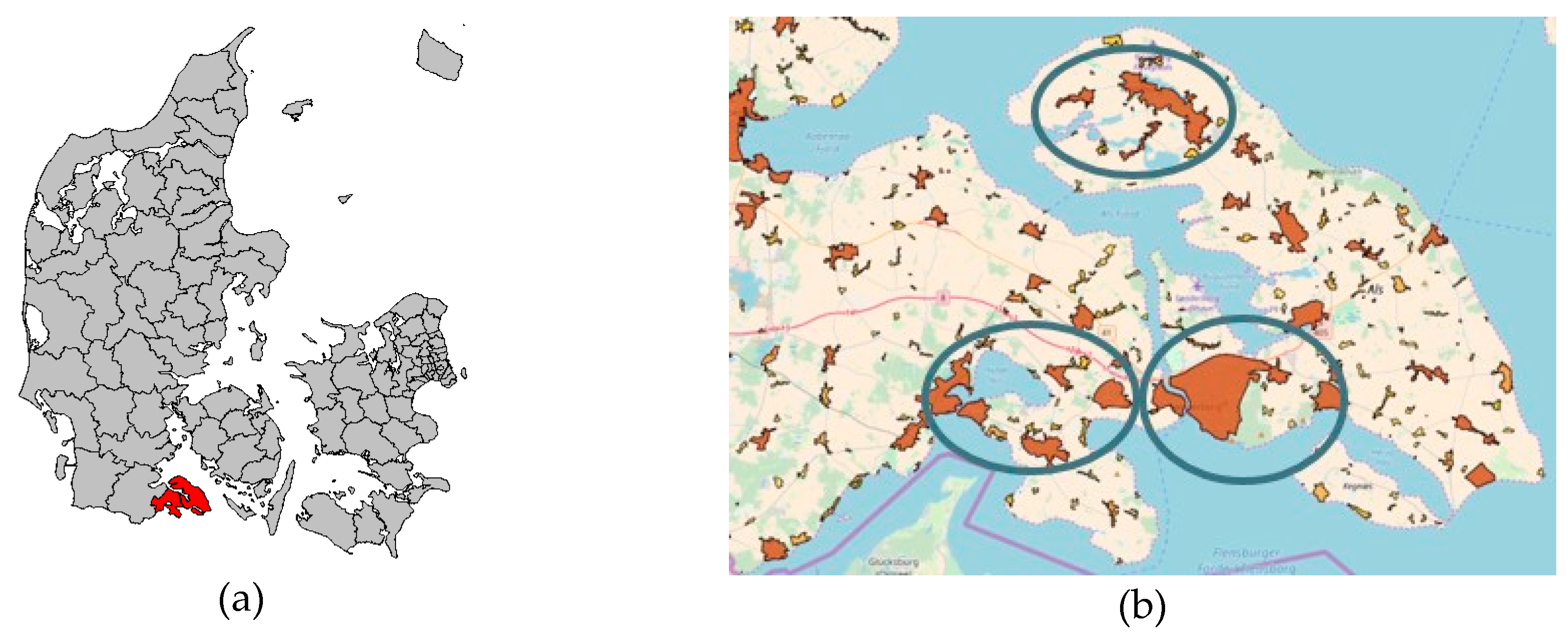
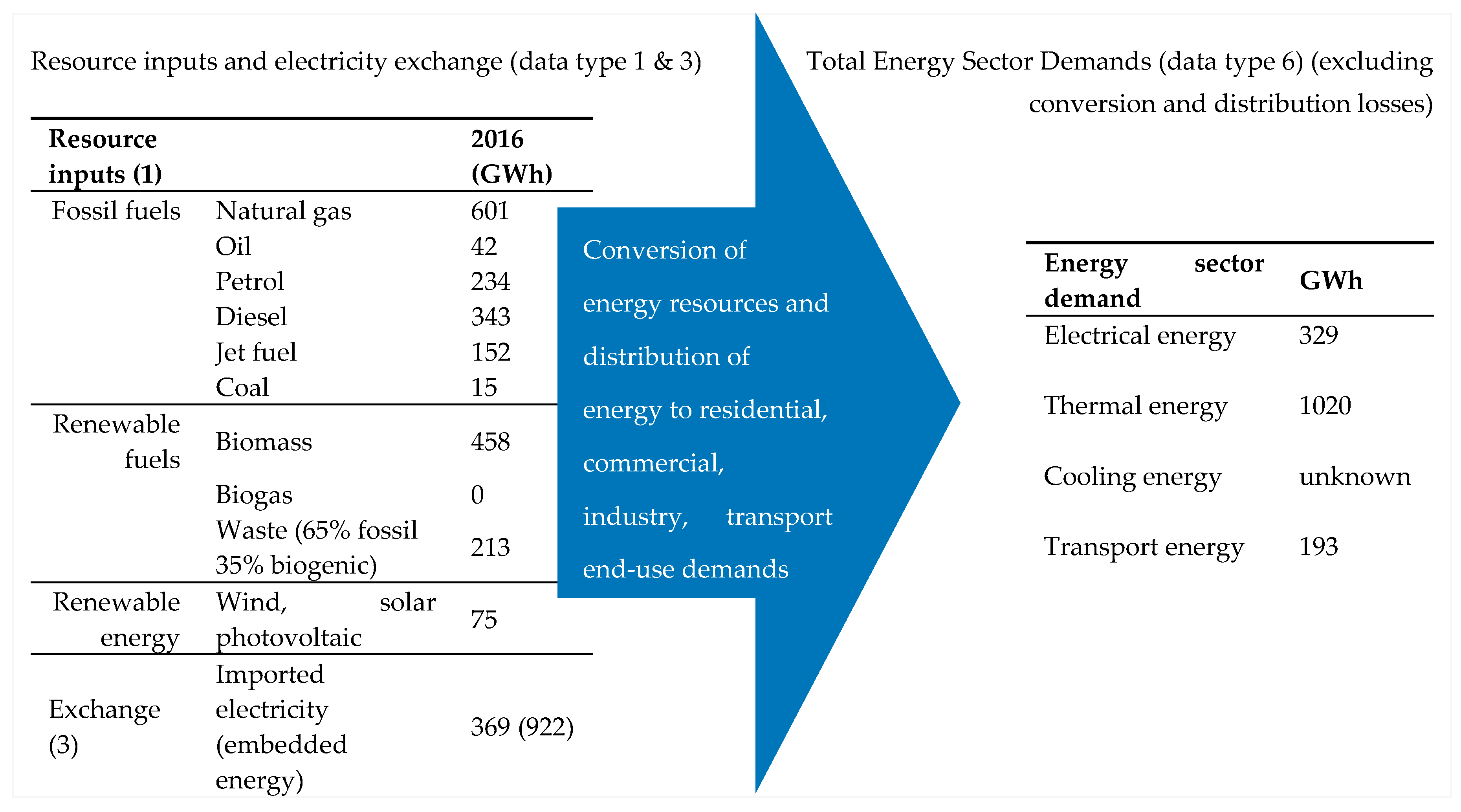
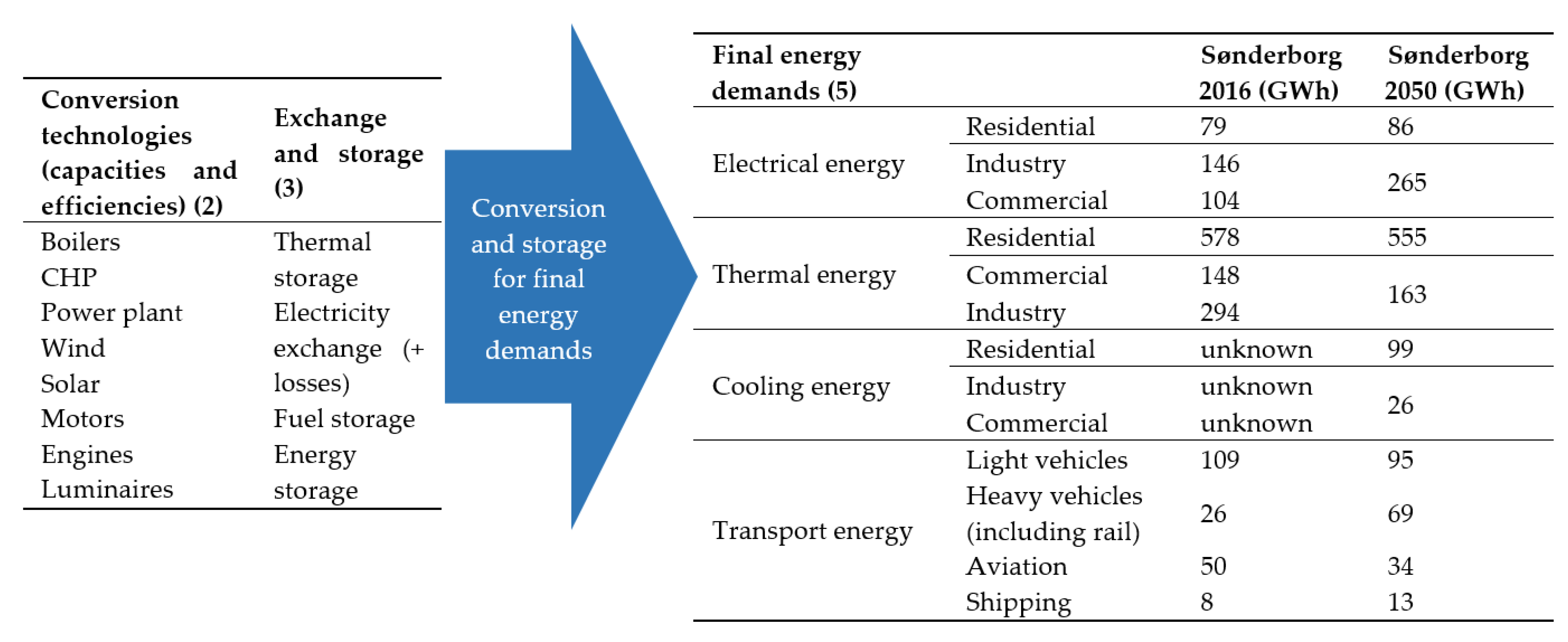

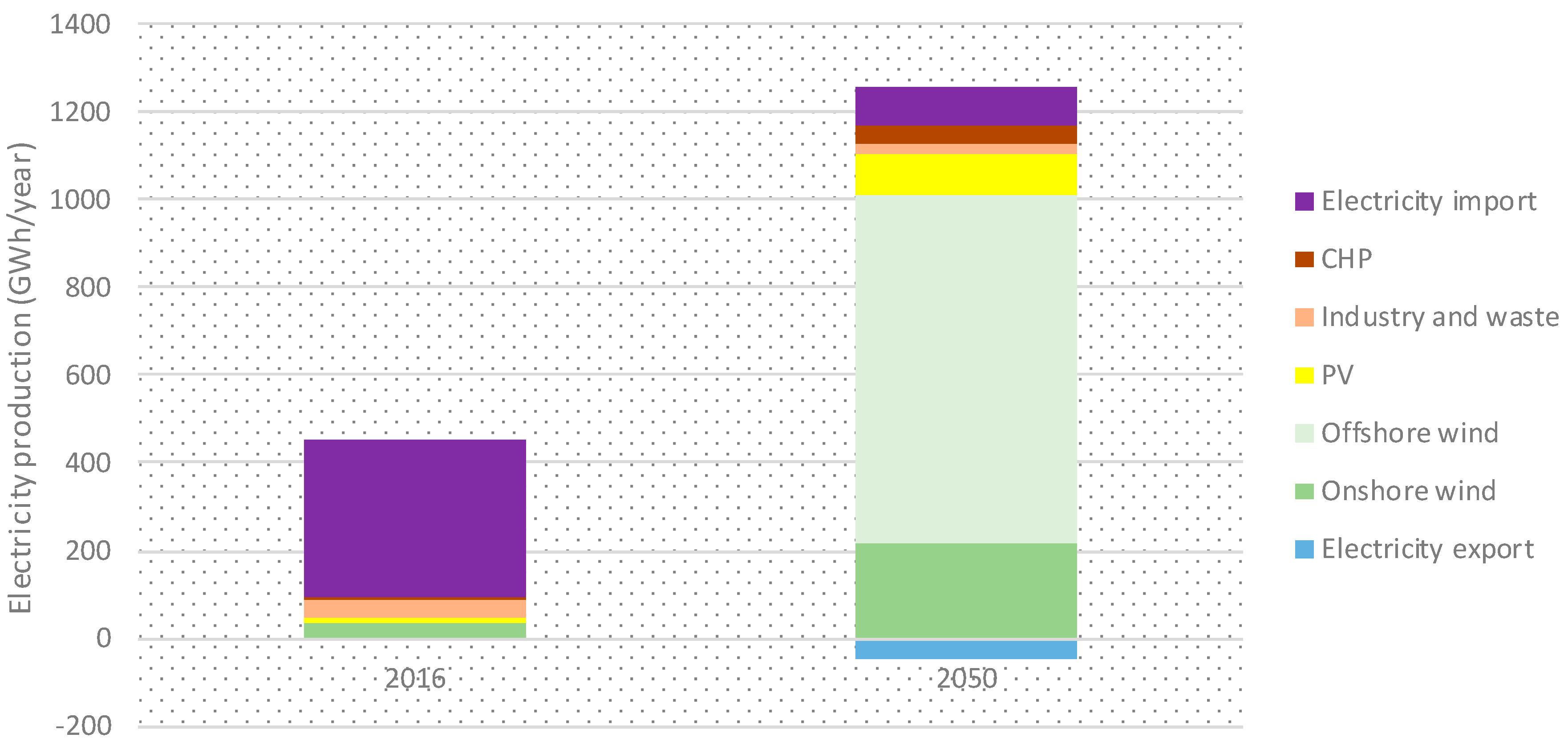
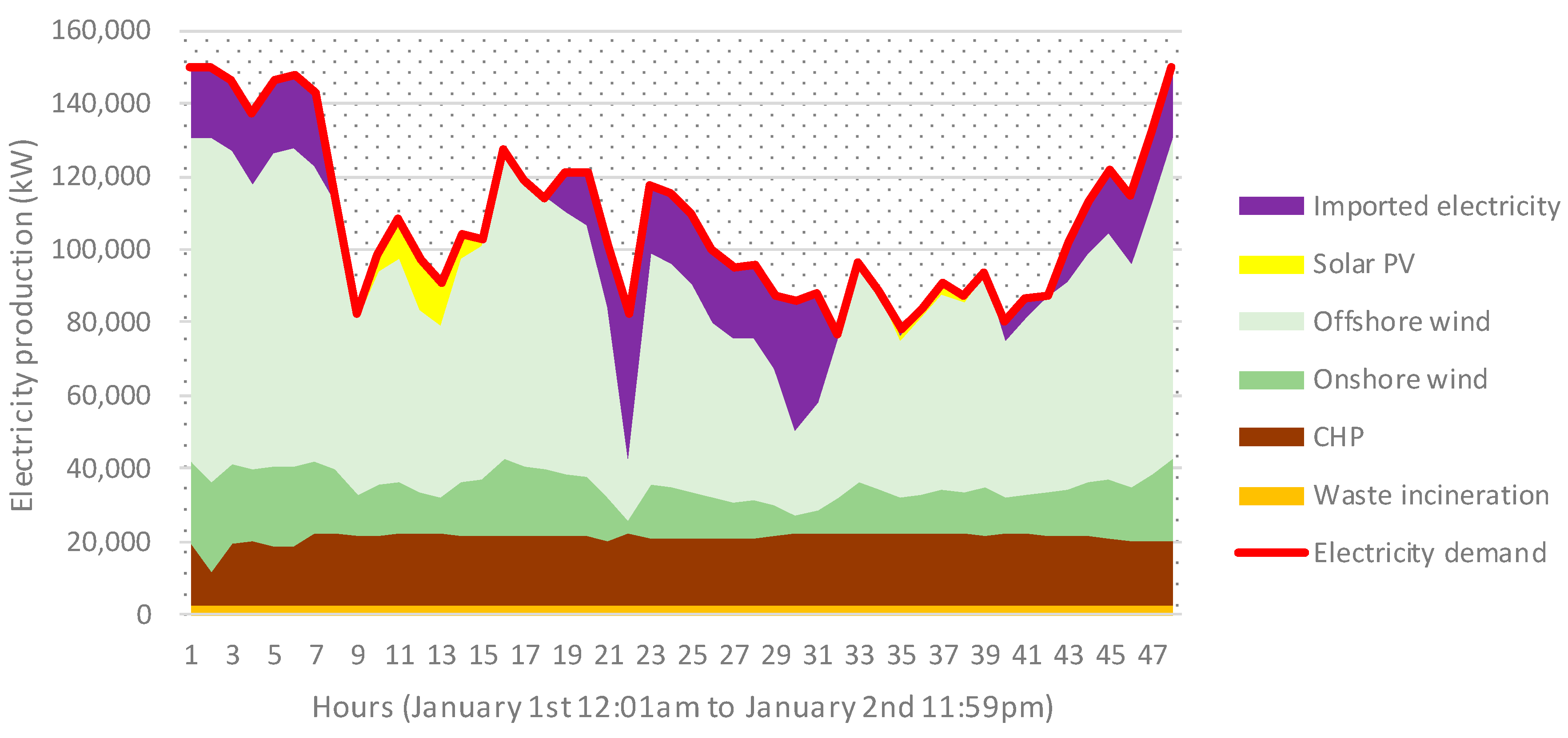
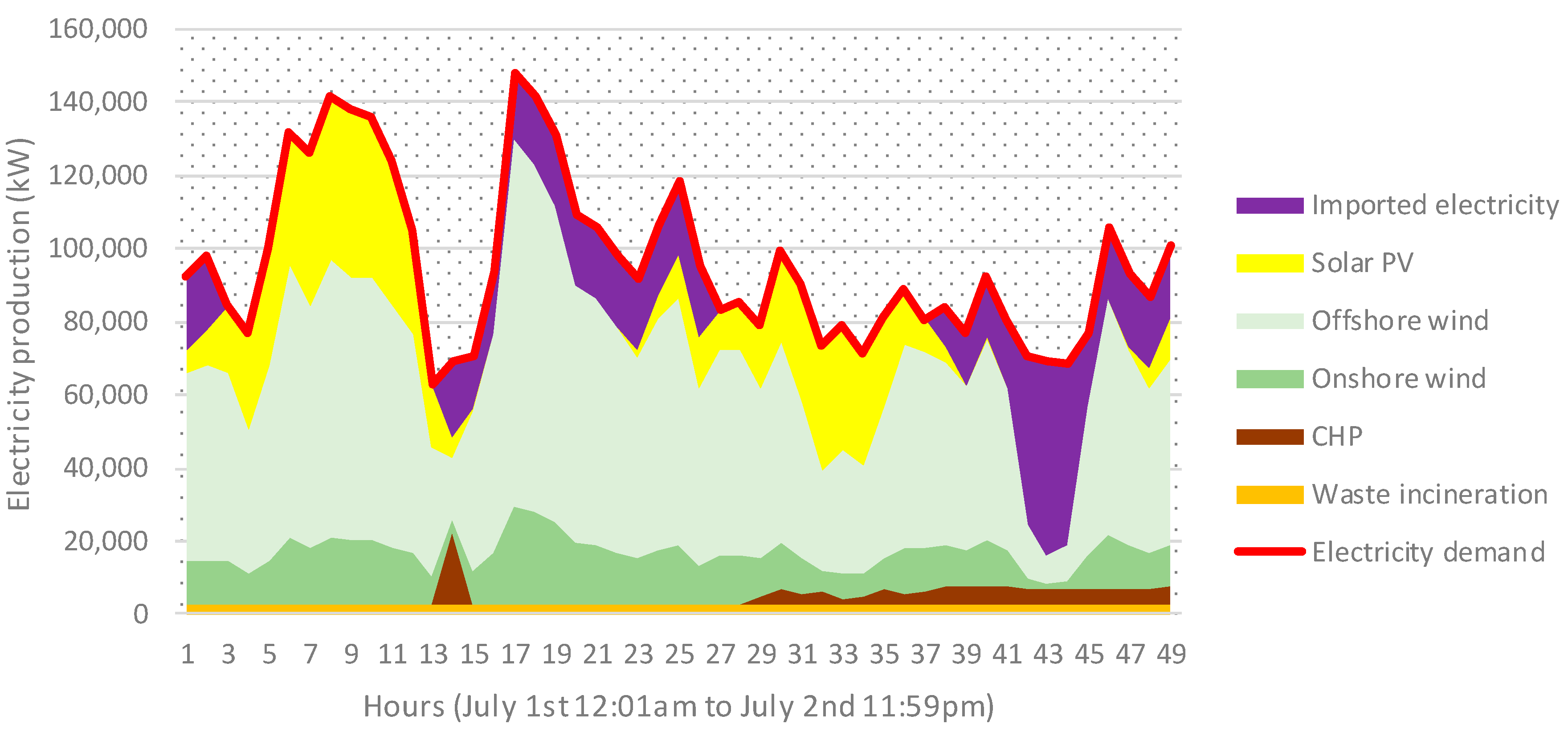

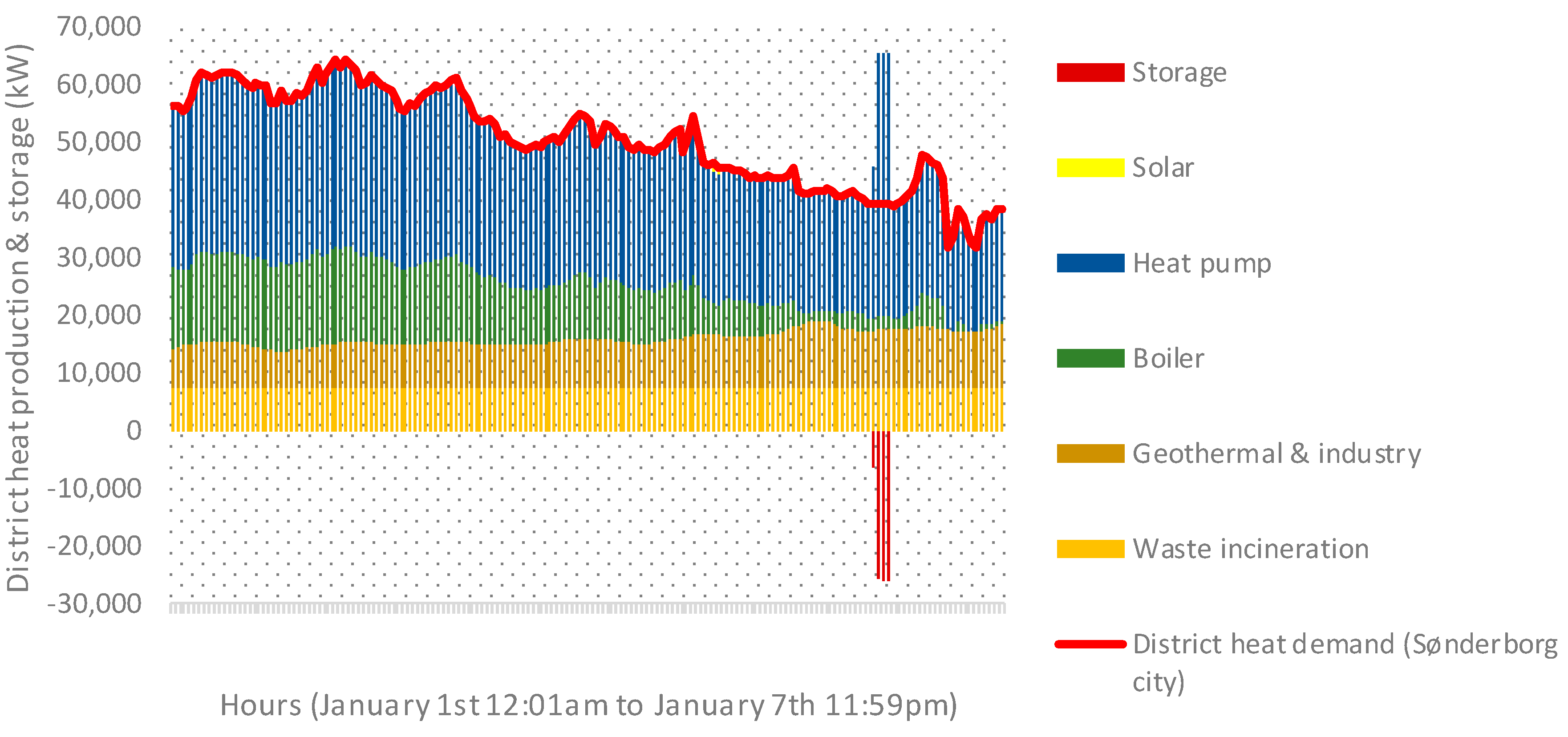
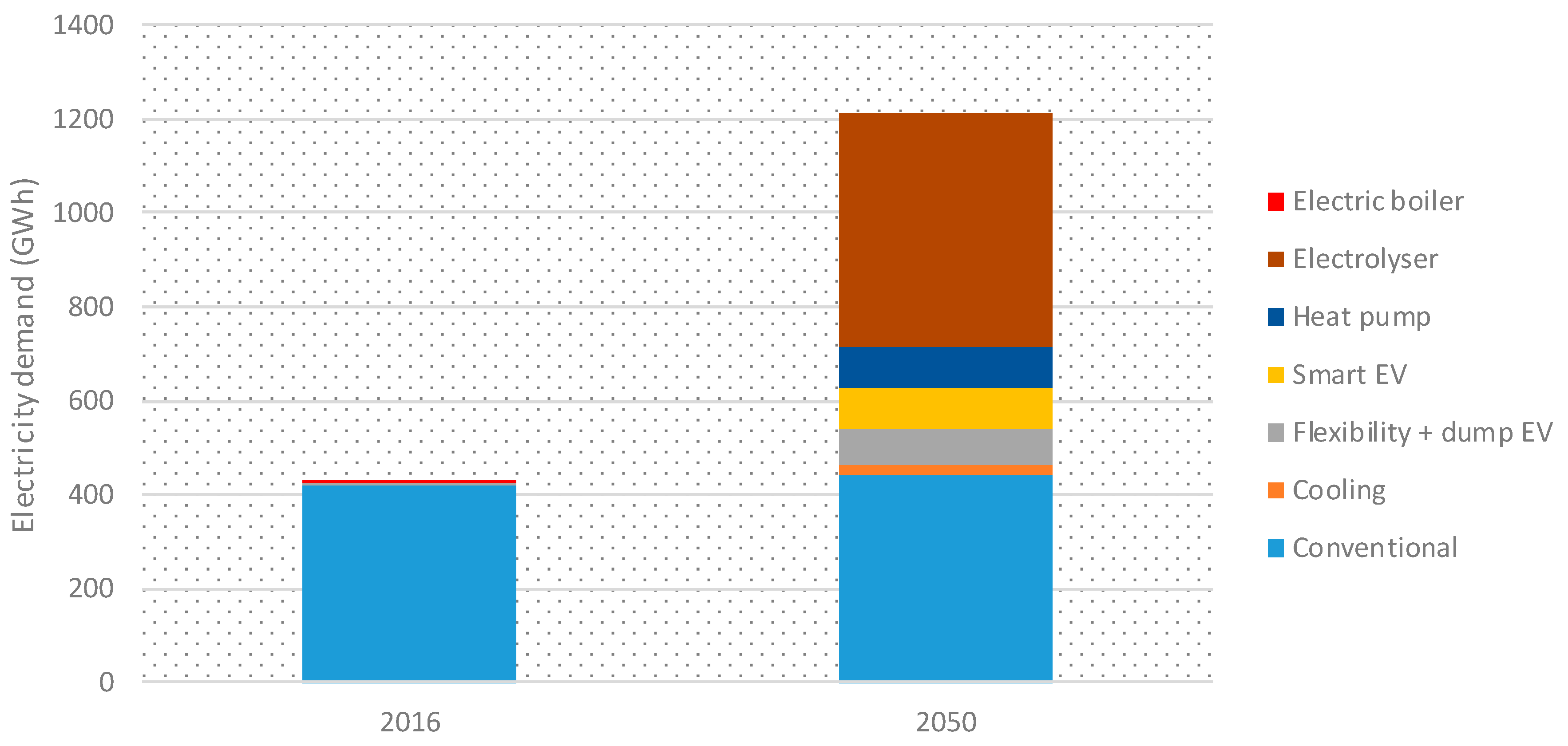
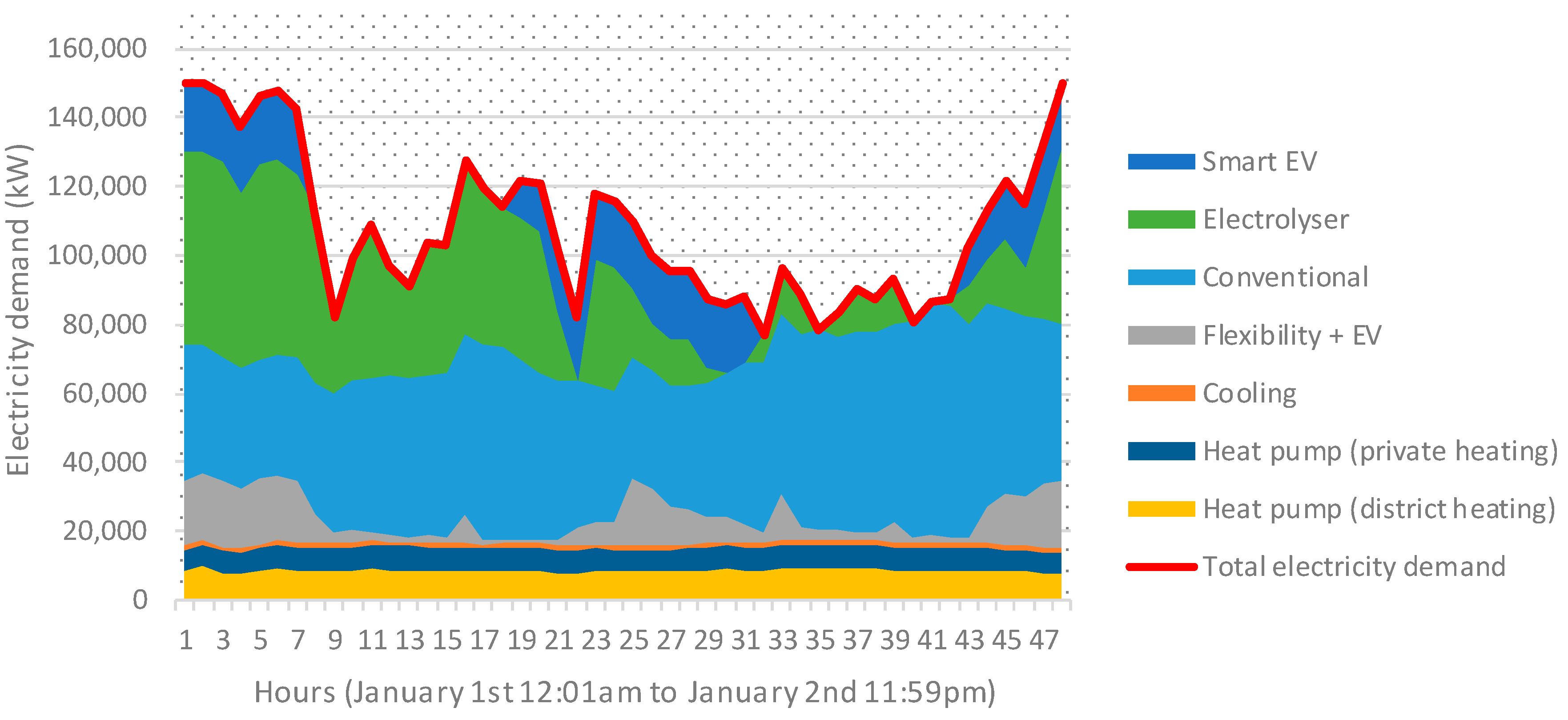
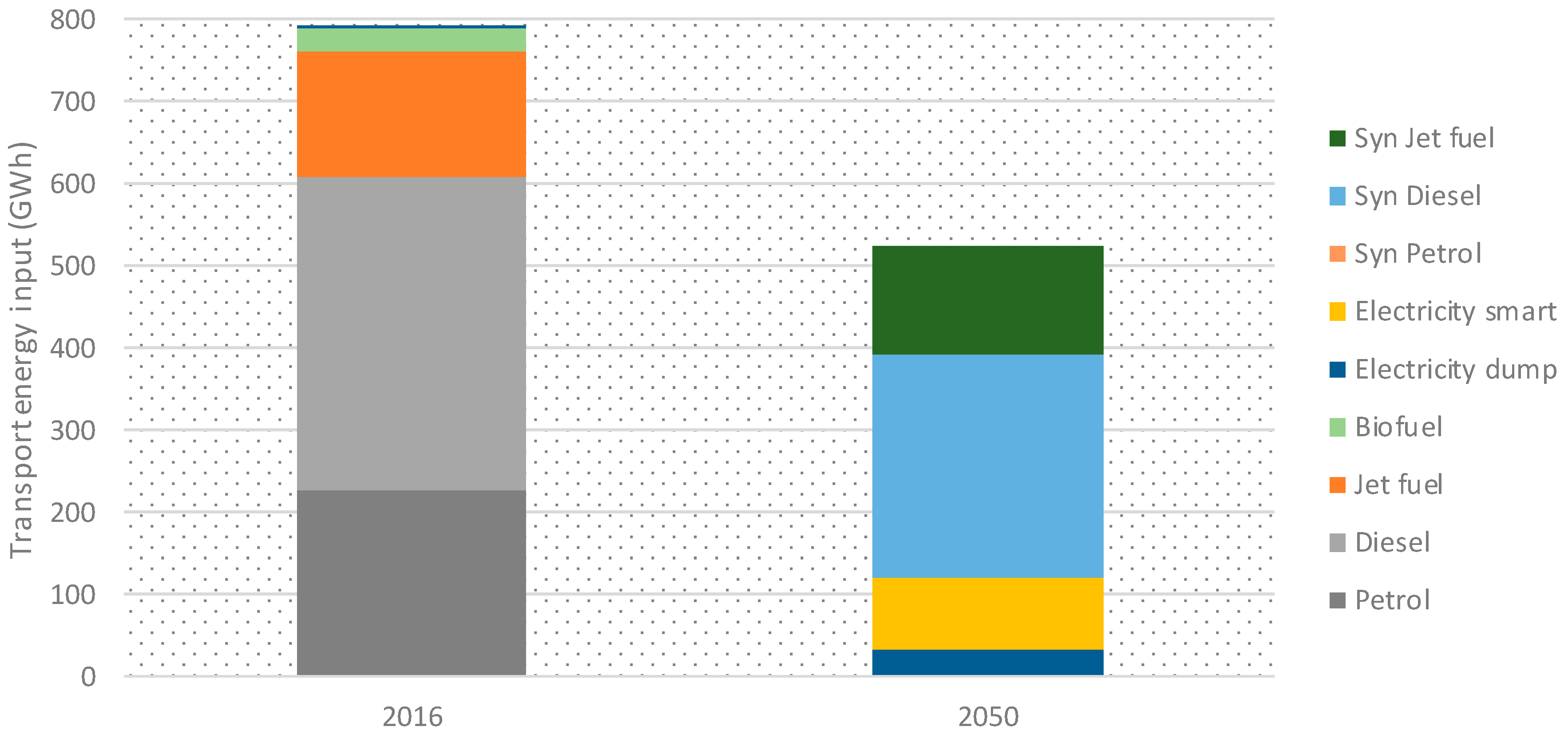
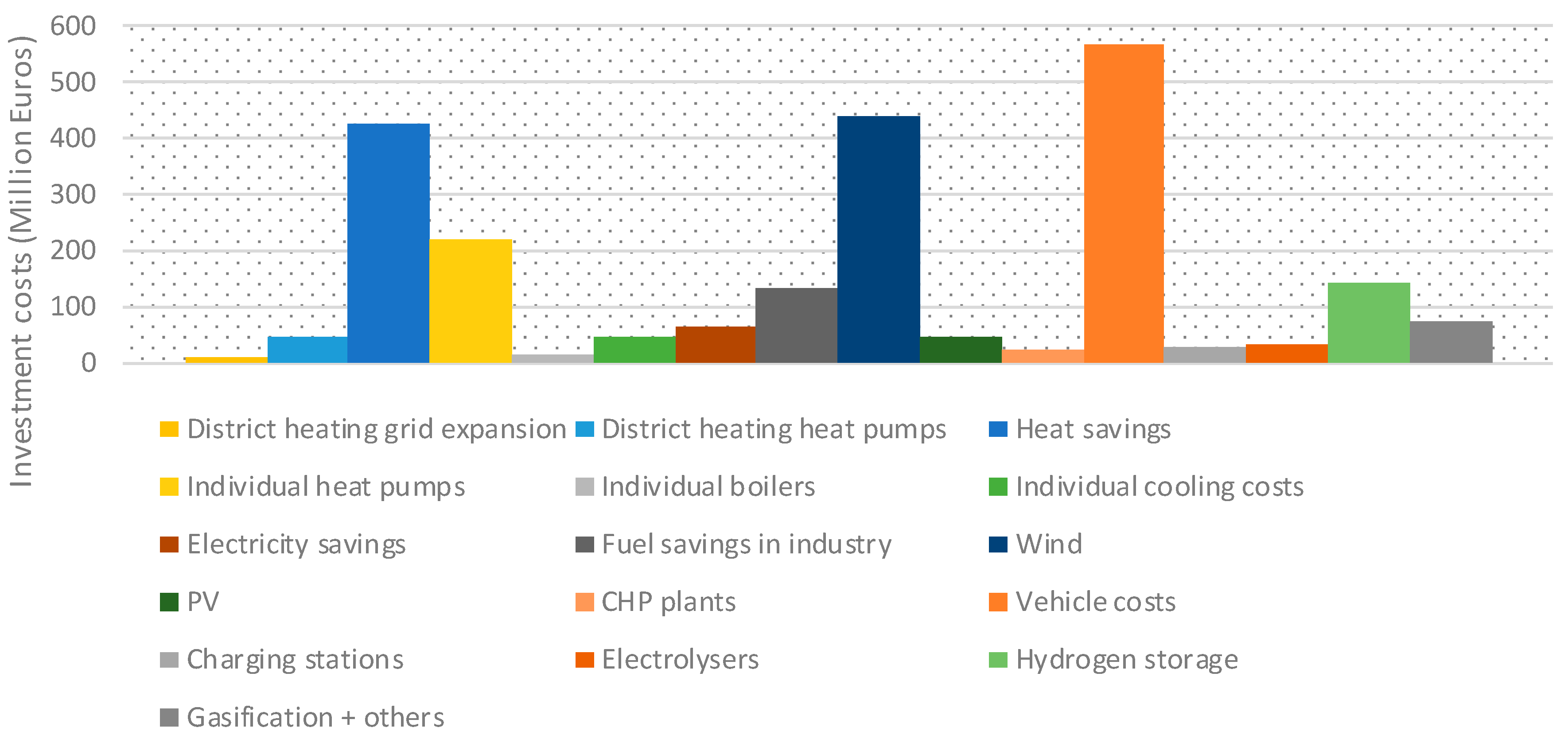

| Smart Energy System Sustainability Factors [10] | Explanation [11] |
|---|---|
| Includes all energy sectors | Decarbonize all energy sectors. Synergies are maximized and resource consumption is minimized |
| Technically feasible design and analysis | Energy imbalances are minimized and unit capacity factors are sufficient |
| Feasible socio-economic costs | Equal to today, sufficient balance of payments, macro-economic fiscal effects |
| Feasible energy security | Energy demands are supplied throughout the year |
| Better efficiency | Resource consumption is minimized |
| Better resource use | Ecosystem services are maintained |
| Better environment | Reduction in climate change, health improvements, jobs created |
| Resource Inputs (1) | Conversion Technologies, Capacities and Efficiencies (2) | Exchange and Storage, Capacities and Efficiencies (3) | End-User Demands (4) | Final Energy Demands (5) | Total Energy Sector Demands (6) | Temporal Demands and Energy Inputs (7) |
|---|---|---|---|---|---|---|
| Fossil fuels; Renewable fuels; Imported electricity; Renewable energy. | Boilers; Combined heat and power plant (CHP); Power plant; Wind; Solar; Motors; Engines; Luminaires. | Thermal storage; Fuel storage; Energy storage; Electricity exchange and distribution (+ losses); District heating distribution (+ losses). | Lighting; Heating; Cooking; Cooling; Driving. | Residential; Industry; Commercial; Light duty vehicles; Heavy duty vehicles. | Electrical energy demand; Thermal energy demand; Cooling energy demand; Transport energy demand. | Hour by hour |
| Conversion Technologies (2) | Electricity Production (GWh) | Thermal Production (GWh) | Final Energy Demands (5) |
|---|---|---|---|
| Wind (onshore) | 33 (100%) | - | Electrical & thermal energy |
| Wind (offshore) | 0 | - | |
| Solar PV | 16 (100%) | - | |
| CHP (decentralized) | 5 (37%) | 6 (49%) | |
| CHP (waste) | 28 (13%) | 159 (75%) | |
| CHP (industry) | 16 (38%) | 19 (46%) | |
| Imported electricity | 369 | - | |
| DH boilers | - | 271 (~102%) | Thermal energy demand |
| DH boiler (electric) | - | 8 (96%) | |
| DH solar thermal | - | 20 (96%) | |
| DH geothermal | - | 5 (100%) | |
| Industry boilers | - | 253 (90%) | |
| Private boilers | - | 324 (~75%) | |
| Solar thermal (private) | - | 2 (100%) | |
| Heat pumps (private) | - | 7 (300%) | |
| Electric heating (private) | - | 15 (~100%) | |
| Private cooling | No data | No data | Cooling energy demand |
| Motors/engines | 1.9 (85%) | 211 (~25%) | Transport energy demand |
| TWh/Year | Energy Component | 2015 | 2050 |
|---|---|---|---|
| Resource inputs (1) | Biomass + waste | 40 | 65 |
| Wind | 11 | 80 | |
| Solar + geothermal | 1 | 16 | |
| Fossil fuels | 155 | 0 | |
| Conversion technologies (2) | Data available but not presented | ||
| Storages and exchange (3) | Electricity import | 0 | 0.8 |
| Electricity export | −2.2 | −14.6 | |
| Electrofuel storage | 0 | 31 | |
| Final energy demands (5) | Data available but not presented | ||
| Total energy sector demand (6) (excluding conversion and distribution losses) | Electricity | 31 | 67 |
| Heating | 42 | 42 | |
| Cooling | 5 | 5 | |
| Transport (Total energy sector demands excluding conversion and distribution losses were not provided for transport so they were estimated based on efficiencies of vehicles today. Efficiencies were 25% light vehicles, 33% for heavy vehicles, 33% for aviation and shipping, and 85% for electric vehicles.) | 16 | 13 | |
| Final Energy Demands (5) | Sønderborg 2016 (GWh) | Sønderborg Based on IDA2015 (GWh) | Sønderborg Difference | |
|---|---|---|---|---|
| Electrical energy | Residential | 79 | 115 | −46% |
| Industry | 146 | 129 | +12% | |
| Commercial | 104 | 112 | −7% | |
| Thermal energy | Residential | 578 | 556 | 4% |
| Commercial | 148 | 316 | +40% | |
| Industry | 294 | |||
| Cooling energy | Residential | unknown | 59 | n/a |
| Industry | unknown | 26 | n/a | |
| Commercial | unknown | n/a | ||
| Transport energy | Light vehicles | 109 | 112 | −7% |
| Heavy vehicles (including rail) | 26 | 35 | −19% | |
| Aviation | 50 | 45 | +11% | |
| Shipping | 8 | 8 | 0% | |
© 2019 by the authors. Licensee MDPI, Basel, Switzerland. This article is an open access article distributed under the terms and conditions of the Creative Commons Attribution (CC BY) license (http://creativecommons.org/licenses/by/4.0/).
Share and Cite
Drysdale, D.; Vad Mathiesen, B.; Lund, H. From Carbon Calculators to Energy System Analysis in Cities. Energies 2019, 12, 2307. https://doi.org/10.3390/en12122307
Drysdale D, Vad Mathiesen B, Lund H. From Carbon Calculators to Energy System Analysis in Cities. Energies. 2019; 12(12):2307. https://doi.org/10.3390/en12122307
Chicago/Turabian StyleDrysdale, David, Brian Vad Mathiesen, and Henrik Lund. 2019. "From Carbon Calculators to Energy System Analysis in Cities" Energies 12, no. 12: 2307. https://doi.org/10.3390/en12122307
APA StyleDrysdale, D., Vad Mathiesen, B., & Lund, H. (2019). From Carbon Calculators to Energy System Analysis in Cities. Energies, 12(12), 2307. https://doi.org/10.3390/en12122307







